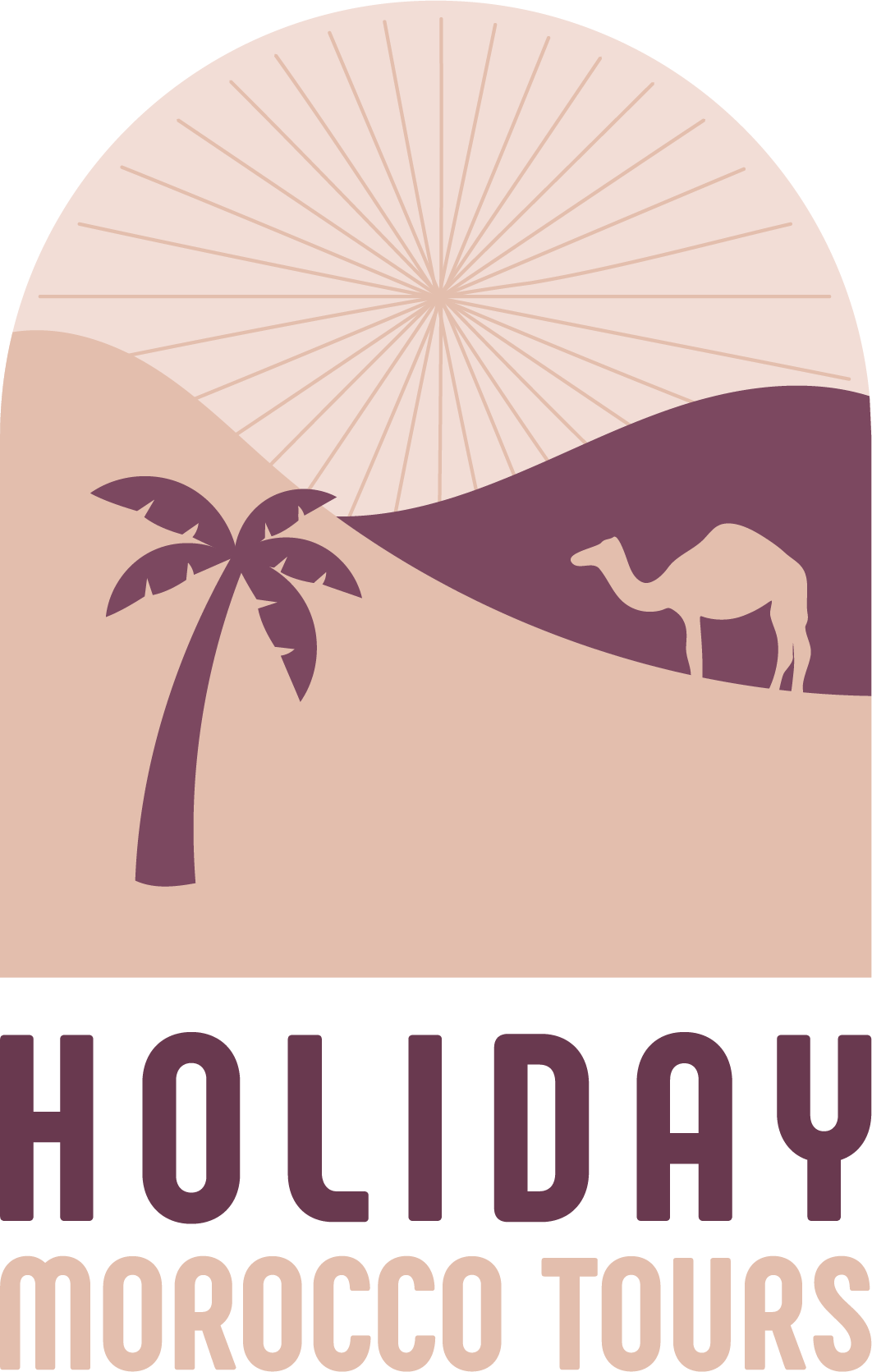Shopping in Traditional Moroccan Souks Guide
Moroccan souks, vibrant marketplaces filled with an array of sights, sounds, and scents, offer an unforgettable shopping experience. Whether you’re wandering through the narrow alleys of Marrakech’s medina, browsing the artisanal stalls in Fes, or exploring coastal marketplaces like Essaouira, the souks are a treasure trove for the adventurous shopper. This guide will help you navigate these traditional Moroccan markets and make the most of your visit.
What Are Souks?
Souks are traditional marketplaces found in Moroccan medinas (old towns). Each souk is typically organized by trade, with sections dedicated to spices, textiles, ceramics, leather goods, and more. Historically, these markets were not only places of commerce but also hubs for social interaction and cultural exchange.
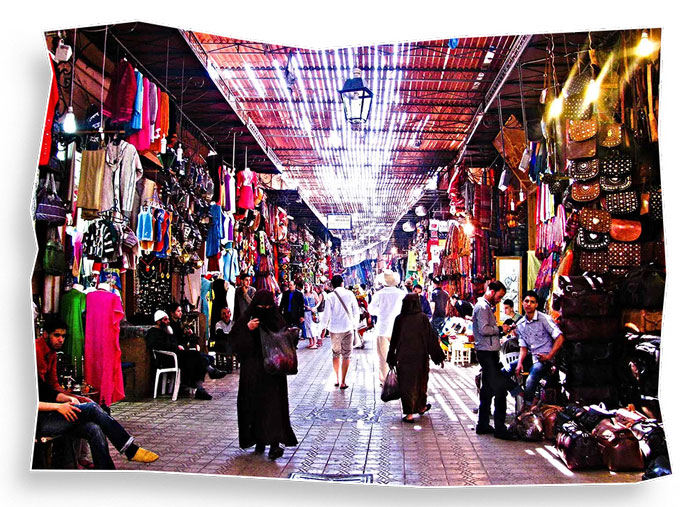
Popular Souks to Visit in Morocco
Marrakech Souks
The souks of Marrakech are among the most famous in Morocco, offering a mesmerizing maze of narrow alleys brimming with vibrant colors, rich aromas, and the sounds of traders calling out their latest offers. The heart of the medina is Souk Semmarine, a bustling marketplace known for its dazzling selection of textiles, intricate lanterns, antiques, and traditional Moroccan slippers (babouches). As you explore deeper, you’ll find Souk El Kebir, renowned for its high-quality leather goods, from handcrafted bags and belts to finely stitched babouches. Each corner of the souks introduces you to a different craft, whether it’s handcrafted jewelry, Berber rugs, or exotic spices. Haggling is part of the experience, so be prepared to negotiate for the best deals while soaking in the intoxicating energy of this historic marketplace.
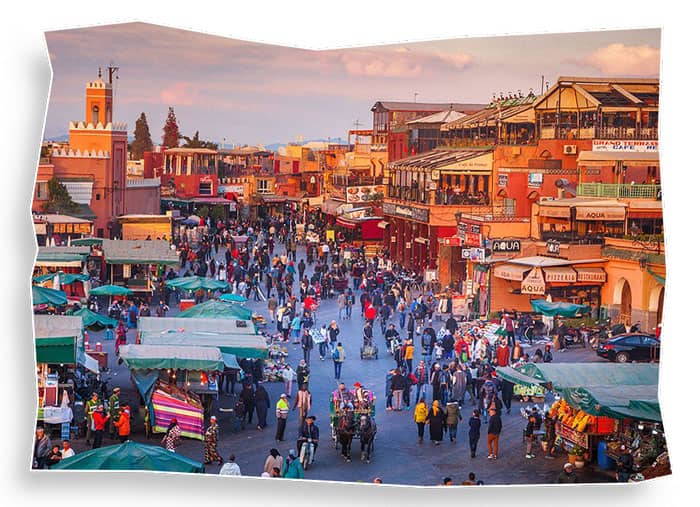
Fes el-Bali Souks
The ancient medina of Fes, a UNESCO World Heritage site, is home to some of Morocco’s most authentic souks. Known for its labyrinthine alleys and traditional craftsmanship, Fes el-Bali offers a glimpse into centuries-old artisanal techniques. The souks here specialize in brassware, intricate zellige tiles, and beautifully painted ceramics. One of the must-visit areas is the leather tannery quarter, where you can witness the age-old process of leather dyeing using natural ingredients. The smell can be strong, but it’s an essential experience in Fes. Other notable markets include the Seffarine Square, where copper and brass artisans craft stunning trays and teapots, and the Attarine Souk, where aromatic spices, perfumes, and medicinal herbs fill the air. Exploring Fes’s souks is like stepping back in time, offering a rich cultural experience unlike any other.
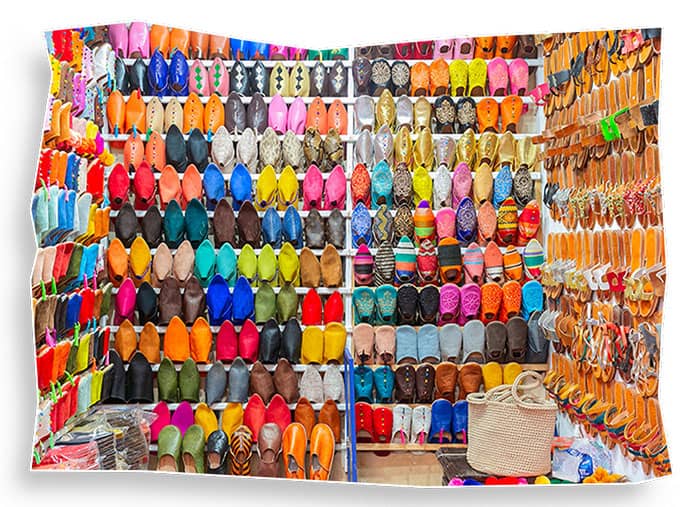
Essaouira Souks
Unlike the bustling markets of Marrakech and Fes, the souks of Essaouira have a more laid-back and coastal charm. Located within the fortified medina, these markets are famous for their exquisite wooden handicrafts made from thuya wood, a rare and beautifully grained wood native to the region. Skilled artisans create everything from jewelry boxes to furniture, often inlaid with mother-of-pearl or intricate carvings. Another highlight of Essaouira’s souks is its argan oil, known for its beauty and culinary uses. You can visit small cooperatives run by Berber women who demonstrate the traditional process of extracting this precious oil. Alongside these treasures, the souks also offer colorful textiles, handcrafted silver jewelry, and fresh seafood straight from the Atlantic. With its relaxed atmosphere and coastal breeze, shopping in Essaouira is a delightful experience.
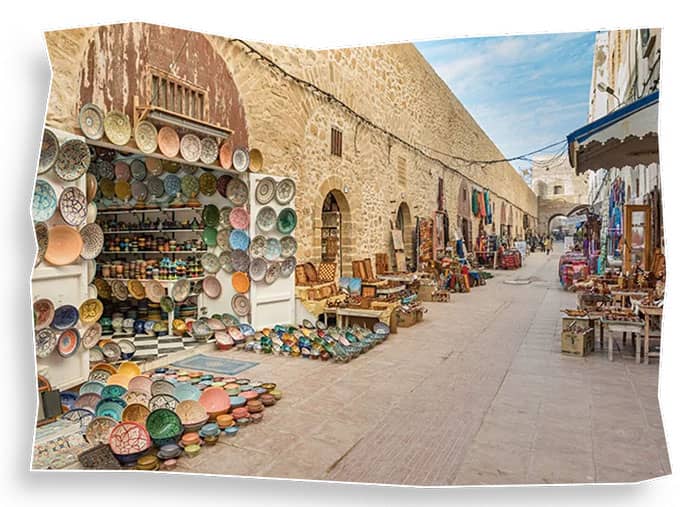
Embark on the Ultimate Morocco Desert Adventure!
Experience the magic of the Sahara—ride camels across golden dunes, witness breathtaking sunsets, sleep under a sky full of stars, and immerse yourself in Berber culture. Whether you seek adventure, relaxation, or cultural discovery, our Morocco Desert Tours offer unforgettable moments tailored just for you!
Chefchaouen Souks
Set against the stunning blue-washed buildings of the Rif Mountains, the souks of Chefchaouen have a unique and charming ambiance. While smaller than those in Marrakech or Fes, these markets are rich in artisanal products that reflect the region’s Berber heritage. Handwoven blankets in vibrant patterns and natural dyes are among the most sought-after items, offering a cozy and authentic Moroccan souvenir. The leather goods in Chefchaouen are also distinct, with hand-tooled bags and wallets often dyed using natural pigments. Herbal shops sell locally sourced teas, spices, and essential oils, while pottery stalls showcase beautifully painted ceramics in blue and white tones that mirror the city’s famous walls. Shopping in Chefchaouen’s souks feels more personal and intimate, with friendly artisans eager to share their craft and stories with visitors.

What to Buy in Moroccan Souks
- Spices and Herbs:
- Look for saffron, cumin, turmeric, and ras el hanout (a spice blend).
- Herbal teas, like Moroccan mint tea ingredients, are also a must-buy.
- Textiles and Carpets:
- Moroccan rugs, such as Beni Ourain and kilims, are world-renowned.
- Check for traditional woven textiles and hand-embroidered items.
- Ceramics and Pottery:
- Vibrant ceramic plates, bowls, and tajines are popular souvenirs.
- Fes is particularly known for its intricate blue and white pottery.
- Leather Goods:
- Morocco is famous for its tanneries, especially in Fes.
- Find leather bags, belts, slippers (babouches), and jackets.
- Jewelry and Accessories:
- Berber silver jewelry, embellished with gemstones, is unique.
- Pick up bracelets, necklaces, and earrings that reflect Moroccan craftsmanship.
- Argan Oil and Cosmetics:
- Pure argan oil is a specialty of Morocco.
- Look for other natural beauty products like black soap and ghassoul clay.
- Lanterns and Decor:
- Moroccan lanterns, made of brass or copper, create stunning ambiance.
- Other home décor items include mosaic tables, mirrors, and carved wooden pieces.
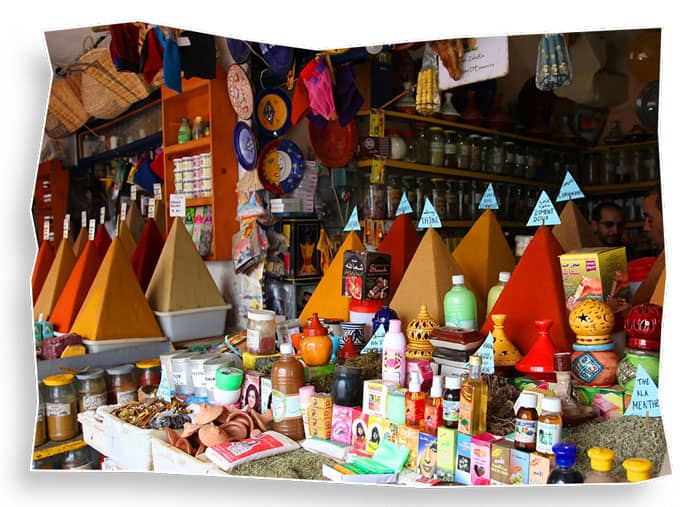
Tips for Navigating Souks
Be Prepared to Haggle:
Bargaining is an integral part of the souk experience. Start by offering about half the initial price and work your way up.
Bring Cash:
Many vendors do not accept credit cards, so it’s essential to have Moroccan dirhams on hand.
Know the Layout:
Souks can be a maze. Pay attention to landmarks and use a guide or GPS app if necessary.
Be Respectful:
Dress modestly and ask permission before taking photos, especially of people.
Timing Matters:
Visit early in the morning for a quieter experience or later in the day for livelier crowds.
Cultural Etiquette in Souks
- Greet vendors with a polite “Salam Alaikum” (peace be upon you).
- If you’re not interested in buying, a simple “La, shukran” (No, thank you) will suffice.
- Avoid pointing with your finger; instead, use your whole hand.
How to Ensure Quality
- Spices: Choose vendors with clean, well-organized stalls.
- Rugs and Textiles: Ask about the origin and material—authentic Moroccan rugs are handwoven.
- Argan Oil: Look for cooperative-made oils with certifications.
- Leather Goods: Smell the item; genuine leather has a distinct aroma.
Immersive Experiences in the Souks
For a deeper connection to Moroccan culture, consider joining a guided tour or a workshop. Many souks offer experiences such as cooking classes, carpet-weaving demonstrations, or pottery-making workshops.
Conclusion
Shopping in Moroccan souks is more than just a retail experience—it’s a cultural journey. From the intricate craftsmanship to the lively atmosphere, every visit offers a glimpse into Morocco’s rich heritage. With this guide, you’re well-equipped to explore these bustling marketplaces, find unique treasures, and create lasting memories.
